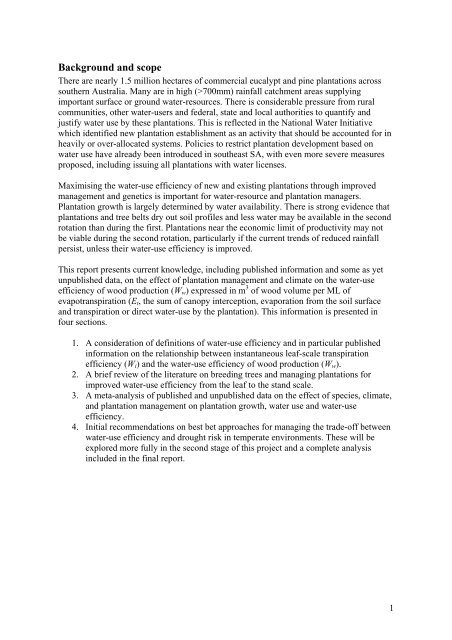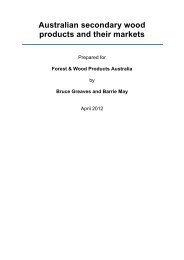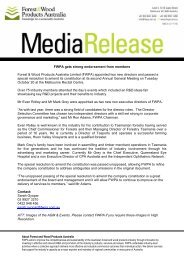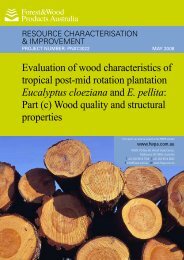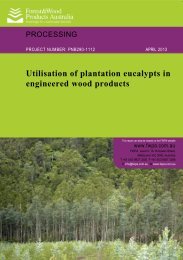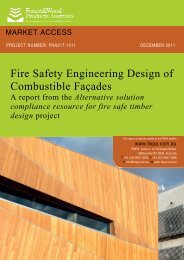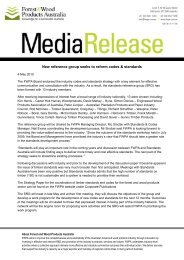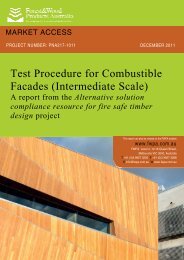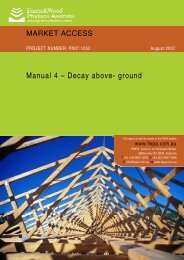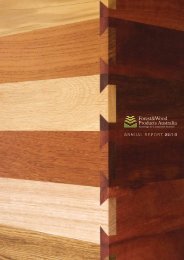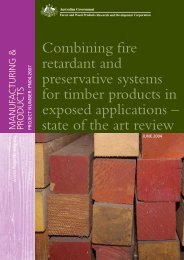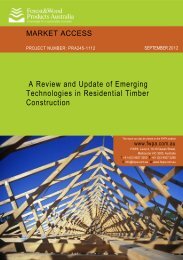Water-use efficient plantations - Forest and Wood Products Australia
Water-use efficient plantations - Forest and Wood Products Australia
Water-use efficient plantations - Forest and Wood Products Australia
Create successful ePaper yourself
Turn your PDF publications into a flip-book with our unique Google optimized e-Paper software.
Background <strong>and</strong> scope<br />
There are nearly 1.5 million hectares of commercial eucalypt <strong>and</strong> pine <strong>plantations</strong> across<br />
southern <strong>Australia</strong>. Many are in high (>700mm) rainfall catchment areas supplying<br />
important surface or ground water-resources. There is considerable pressure from rural<br />
communities, other water-<strong>use</strong>rs <strong>and</strong> federal, state <strong>and</strong> local authorities to quantify <strong>and</strong><br />
justify water <strong>use</strong> by these <strong>plantations</strong>. This is reflected in the National <strong>Water</strong> Initiative<br />
which identified new plantation establishment as an activity that should be accounted for in<br />
heavily or over-allocated systems. Policies to restrict plantation development based on<br />
water <strong>use</strong> have already been introduced in southeast SA, with even more severe measures<br />
proposed, including issuing all <strong>plantations</strong> with water licenses.<br />
Maximising the water-<strong>use</strong> efficiency of new <strong>and</strong> existing <strong>plantations</strong> through improved<br />
management <strong>and</strong> genetics is important for water-resource <strong>and</strong> plantation managers.<br />
Plantation growth is largely determined by water availability. There is strong evidence that<br />
<strong>plantations</strong> <strong>and</strong> tree belts dry out soil profiles <strong>and</strong> less water may be available in the second<br />
rotation than during the first. Plantations near the economic limit of productivity may not<br />
be viable during the second rotation, particularly if the current trends of reduced rainfall<br />
persist, unless their water-<strong>use</strong> efficiency is improved.<br />
This report presents current knowledge, including published information <strong>and</strong> some as yet<br />
unpublished data, on the effect of plantation management <strong>and</strong> climate on the water-<strong>use</strong><br />
efficiency of wood production (Ww) expressed in m 3 of wood volume per ML of<br />
evapotranspiration (Et, the sum of canopy interception, evaporation from the soil surface<br />
<strong>and</strong> transpiration or direct water-<strong>use</strong> by the plantation). This information is presented in<br />
four sections.<br />
1. A consideration of definitions of water-<strong>use</strong> efficiency <strong>and</strong> in particular published<br />
information on the relationship between instantaneous leaf-scale transpiration<br />
efficiency (Wi) <strong>and</strong> the water-<strong>use</strong> efficiency of wood production (Ww).<br />
2. A brief review of the literature on breeding trees <strong>and</strong> managing <strong>plantations</strong> for<br />
improved water-<strong>use</strong> efficiency from the leaf to the st<strong>and</strong> scale.<br />
3. A meta-analysis of published <strong>and</strong> unpublished data on the effect of species, climate,<br />
<strong>and</strong> plantation management on plantation growth, water <strong>use</strong> <strong>and</strong> water-<strong>use</strong><br />
efficiency.<br />
4. Initial recommendations on best bet approaches for managing the trade-off between<br />
water-<strong>use</strong> efficiency <strong>and</strong> drought risk in temperate environments. These will be<br />
explored more fully in the second stage of this project <strong>and</strong> a complete analysis<br />
included in the final report.<br />
1


